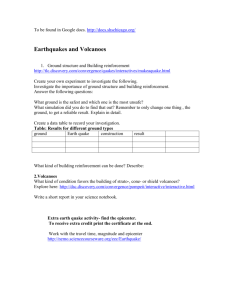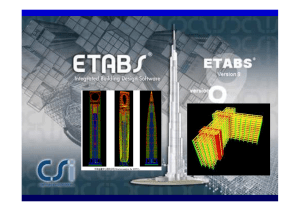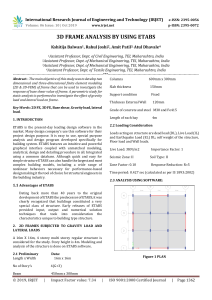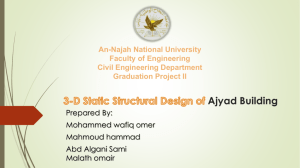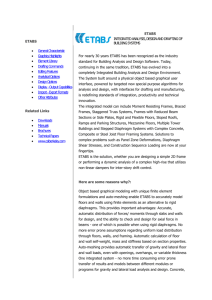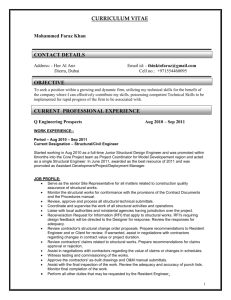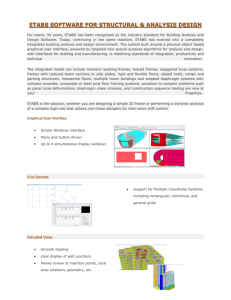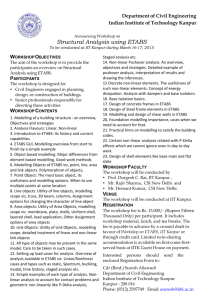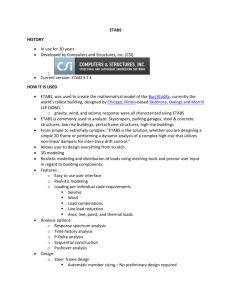EQ Analysis and Design of Building Frame Using ETABS
advertisement
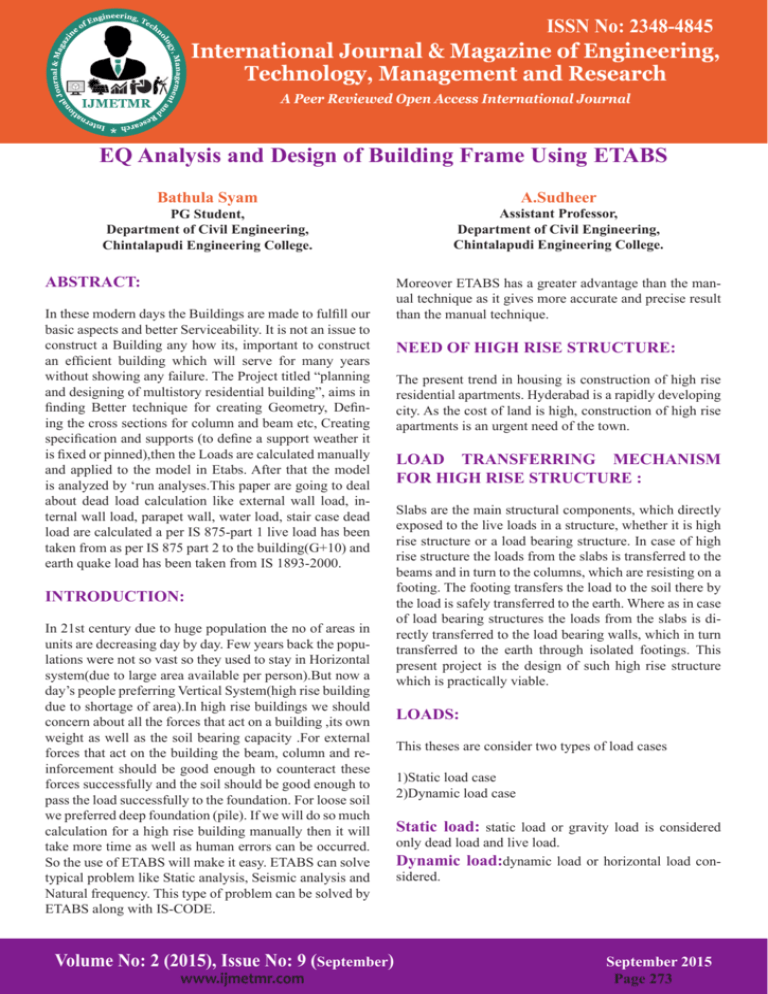
ISSN No: 2348-4845 International Journal & Magazine of Engineering, Technology, Management and Research A Peer Reviewed Open Access International Journal EQ Analysis and Design of Building Frame Using ETABS Bathula Syam PG Student, Department of Civil Engineering, Chintalapudi Engineering College. ABSTRACT: In these modern days the Buildings are made to fulfill our basic aspects and better Serviceability. It is not an issue to construct a Building any how its, important to construct an efficient building which will serve for many years without showing any failure. The Project titled “planning and designing of multistory residential building”, aims in finding Better technique for creating Geometry, Defining the cross sections for column and beam etc, Creating specification and supports (to define a support weather it is fixed or pinned),then the Loads are calculated manually and applied to the model in Etabs. After that the model is analyzed by ‘run analyses.This paper are going to deal about dead load calculation like external wall load, internal wall load, parapet wall, water load, stair case dead load are calculated a per IS 875-part 1 live load has been taken from as per IS 875 part 2 to the building(G+10) and earth quake load has been taken from IS 1893-2000. INTRODUCTION: In 21st century due to huge population the no of areas in units are decreasing day by day. Few years back the populations were not so vast so they used to stay in Horizontal system(due to large area available per person).But now a day’s people preferring Vertical System(high rise building due to shortage of area).In high rise buildings we should concern about all the forces that act on a building ,its own weight as well as the soil bearing capacity .For external forces that act on the building the beam, column and reinforcement should be good enough to counteract these forces successfully and the soil should be good enough to pass the load successfully to the foundation. For loose soil we preferred deep foundation (pile). If we will do so much calculation for a high rise building manually then it will take more time as well as human errors can be occurred. So the use of ETABS will make it easy. ETABS can solve typical problem like Static analysis, Seismic analysis and Natural frequency. This type of problem can be solved by ETABS along with IS-CODE. Volume No: 2 (2015), Issue No: 9 (September) www.ijmetmr.com A.Sudheer Assistant Professor, Department of Civil Engineering, Chintalapudi Engineering College. Moreover ETABS has a greater advantage than the manual technique as it gives more accurate and precise result than the manual technique. NEED OF HIGH RISE STRUCTURE: The present trend in housing is construction of high rise residential apartments. Hyderabad is a rapidly developing city. As the cost of land is high, construction of high rise apartments is an urgent need of the town. LOAD TRANSFERRING MECHANISM FOR HIGH RISE STRUCTURE : Slabs are the main structural components, which directly exposed to the live loads in a structure, whether it is high rise structure or a load bearing structure. In case of high rise structure the loads from the slabs is transferred to the beams and in turn to the columns, which are resisting on a footing. The footing transfers the load to the soil there by the load is safely transferred to the earth. Where as in case of load bearing structures the loads from the slabs is directly transferred to the load bearing walls, which in turn transferred to the earth through isolated footings. This present project is the design of such high rise structure which is practically viable. LOADS: This theses are consider two types of load cases 1)Static load case 2)Dynamic load case Static load: static load or gravity load is considered only dead load and live load. Dynamic load:dynamic load or horizontal load considered. September 2015 Page 273 ISSN No: 2348-4845 International Journal & Magazine of Engineering, Technology, Management and Research A Peer Reviewed Open Access International Journal PLAN AND DIMENTIONS: Fig2: Render view of the plan Plan DESCRIPTION OF STRUCTURE The size of the building is 23.07 m length and 21.54 m width at ground floor level ( As per architectural drawings). No of floor = Ground + 10 floors Floor heights = 3.0m Total height of the building = 30m ( from ground floor to top Floor level ) MATERIAL PROPOERTIES For this thesis, M30 grade concrete was used. The grade of steel used for main reinforcement is Fe500 and shear reinforcement is Fe415. BUILDING MODELLING DESIGN AND RESULTS After the analysis the design was done as per IS 456:2000 in E tabs. The optimize design was found to the structure. THE COLUMN SIZES AFTER DESIGN The ground to second floor column sizes are = 300X750mm Third floor to seventh floor column sizes are =230X680mm Eighth floor tenth floor column sizes are = 230X600 mm REINFORCEMENT PERCENTAGE The percentage of reinforcement is 0.8% for max of all columns, the maximum reinforcement for column is 4.2%. The column-beam system building is modeled in ETABS as a space frame. CONCLUSION: Fig 1: Plan of the building Volume No: 2 (2015), Issue No: 9 (September) www.ijmetmr.com This study deals with the analytical investigation of a structure subjected to gravity and lateral loads. Based on the results the following conclusions are drawn. September 2015 Page 274 ISSN No: 2348-4845 International Journal & Magazine of Engineering, Technology, Management and Research A Peer Reviewed Open Access International Journal •The model has been solved in 8 modes •The mass participation is more than 90% [4]IS:1893(Part-1):2002,Criteria for earth quake resistant design of structure. •The optimise design has been found [5]IS:13920:1993,Ductile detailing of RCC structure subjected to earth quake force. •The mode has been analysed and design for G+10 for Bangalore. [6]SP:16,Design Aid IS:456:2000. REFERENCES: [7]Ramamurtham,Theory of structures . [1].Murthy C.V.R, Learning earthquake design . [8] Ashimbayev M.U., Itskov I.E., Lobodryga T.D.,living with natural and technological hazards, topic a.2: reducing vulnerabilities in existing building and lifelines. [2]Agrawal, Shrikhande Mansih, earth quake resistant design of structures . for Reinforced concrete to [3]IS:456:2000,Plain and Reinforced code of practice. Volume No: 2 (2015), Issue No: 9 (September) www.ijmetmr.com September 2015 Page 275
